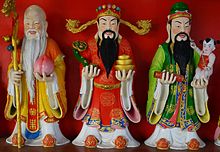Fu Lu Shou
| Sanxing | |||||||||||||||

Shou, Lu, and Fu gods at a Chinese folk religious temple in Thailand.
|
|||||||||||||||
| Chinese name | |||||||||||||||
|---|---|---|---|---|---|---|---|---|---|---|---|---|---|---|---|
| Traditional Chinese | 福祿壽 | ||||||||||||||
| Simplified Chinese | 福禄寿 | ||||||||||||||
|
|||||||||||||||
| Vietnamese name | |||||||||||||||
| Vietnamese alphabet | Phúc Lộc Thọ | ||||||||||||||
| Transcriptions | |
|---|---|
| Standard Mandarin | |
| Hanyu Pinyin | Fú Lù Shòu |
| Yue: Cantonese | |
| Jyutping | Fuk1 Luk6 Sau6 |
| Southern Min | |
| Hokkien POJ | Hok-lo̍k-siū |
The Sanxing (三星 "Three Stars"), who are Fu, Lu, and Shou (simplified Chinese: ; traditional Chinese: ; pinyin: Fú Lù Shòu), or Cai, Zi and Shou (財子壽), are the gods of the three stars and the three qualities of Prosperity (Fu), Status (Lu), and Longevity (Shou) in Chinese religion. These icons are thought to date back to the Ming dynasty, when the gods of the three stars were represented in human form for the first time. They are sometimes identified with other deities of the Chinese religion or of Taoism.
The term is commonly used in Chinese culture to denote the three attributes of a good life. Statues of these three gods are found on the facades of folk religion's temples and ancestral shrines, in nearly every Chinese home and many Chinese-owned shops on small altars with a glass of water, an orange or other auspicious offerings, especially during Chinese New Year. Traditionally, they are arranged right to left (so Shou is on the left of the viewer, Lu in the middle, and Fu on the far right), just as Chinese characters are traditionally written from right to left.
The star of Fu (福), Fuxing 福星, refers to the planet Jupiter. In traditional astrology, the planet Jupiter was believed to be auspicious. Alternatively, according to a Taoist myth of the Ming dynasty, the Fu star is associated with Yang Cheng, a governor of Daozhou in Western Han (206 BC - 24 AD). Yang Cheng risked his life by writing a memorial to the emperor to save the people from presenting dwarf slaves as the special tribute to the imperial court. After his death, the people built a temple to commemorate him, and over time he came to be considered the personification of good fortune.
He is generally depicted in scholar's dress, holding a scroll, on which is sometimes written the character "Fu". He may also be seen holding a child, or surrounded by children. He is sometimes conflated with Caishen, the "Wealth God".
The star of Lu (禄), Luxing 禄星, is ζ Ursa Majoris, or, in traditional Chinese astronomy, the sixth star in the Wenchang cluster, and like the Fu star came to be personified. The Lu star is believed to be Zhang Xian who lived during the Later Shu dynasty. The word lu specifically refers to the salary of a government official. As such, the Lu star is the star of prosperity, rank, and influence.
...
Wikipedia
